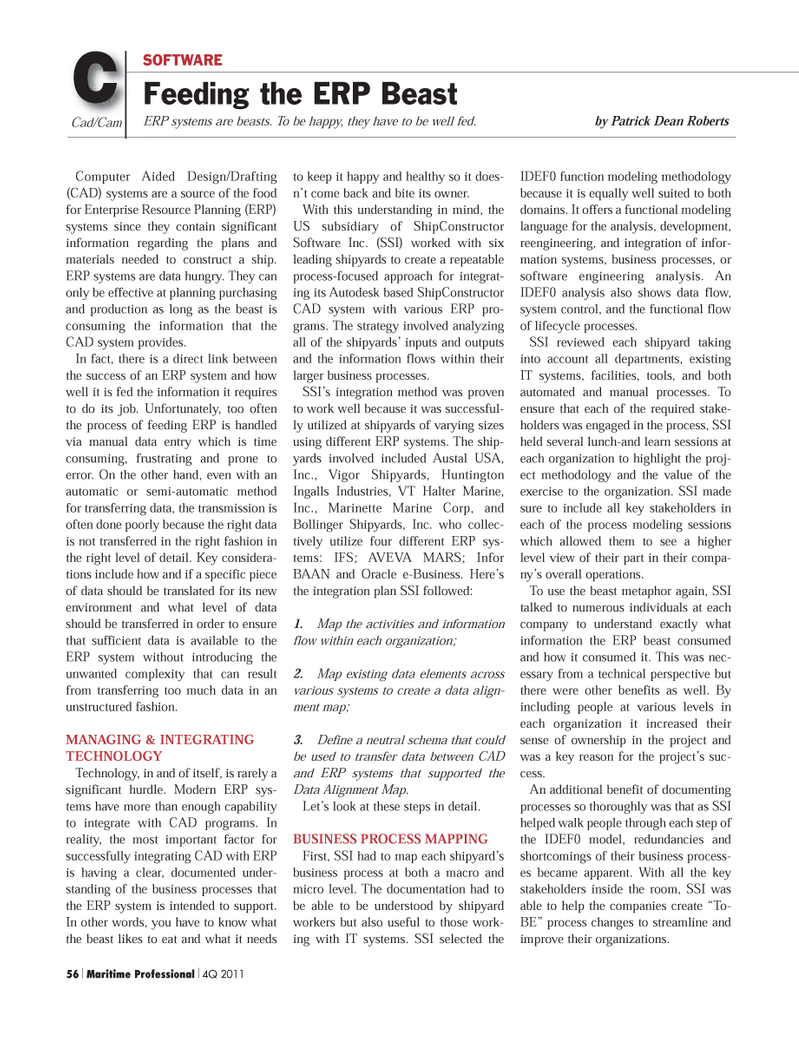
Page 56: of Maritime Logistics Professional Magazine (Q4 2011)
Classification
Read this page in Pdf, Flash or Html5 edition of Q4 2011 Maritime Logistics Professional Magazine
56 Maritime Professional 4Q 2011CCad/CamFeeding the ERP BeastERP systems are beasts. To be happy, they have to be well fed. by Patrick Dean Roberts SOFTWARE Computer Aided Design/Drafting (CAD) systems are a source of the foodfor Enterprise Resource Planning (ERP)systems since they contain significant information regarding the plans and materials needed to construct a ship.ERP systems are data hungry. They can only be effective at planning purchasing and production as long as the beast isconsuming the information that theCAD system provides. In fact, there is a direct link between the success of an ERP system and how well it is fed the information it requiresto do its job. Unfortunately, too often the process of feeding ERP is handledvia manual data entry which is timeconsuming, frustrating and prone toerror. On the other hand, even with an automatic or semi-automatic methodfor transferring data, the transmission isoften done poorly because the right datais not transferred in the right fashion in the right level of detail. Key considera- tions include how and if a specific piece of data should be translated for its new environment and what level of data should be transferred in order to ensurethat sufficient data is available to the ERP system without introducing theunwanted complexity that can result from transferring too much data in anunstructured fashion. MANAGING & INTEGRATING TECHNOLOGYTechnology, in and of itself, is rarely a significant hurdle. Modern ERP sys-tems have more than enough capability to integrate with CAD programs. In reality, the most important factor for successfully integrating CAD with ERP is having a clear, documented under- standing of the business processes that the ERP system is intended to support.In other words, you have to know what the beast likes to eat and what it needs to keep it happy and healthy so it does- n?t come back and bite its owner. With this understanding in mind, the US subsidiary of ShipConstructorSoftware Inc. (SSI) worked with six leading shipyards to create a repeatable process-focused approach for integrat- ing its Autodesk based ShipConstructor CAD system with various ERP pro- grams. The strategy involved analyzing all of the shipyards? inputs and outputs and the information flows within their larger business processes. SSI?s integration method was proven to work well because it was successful- ly utilized at shipyards of varying sizes using different ERP systems. The ship- yards involved included Austal USA, Inc., Vigor Shipyards, Huntington Ingalls Industries, VT Halter Marine, Inc., Marinette Marine Corp, andBollinger Shipyards, Inc. who collec- tively utilize four different ERP sys- tems: IFS; AVEVA MARS; Infor BAAN and Oracle e-Business. Here?s the integration plan SSI followed: 1.Map the activities and informationflow within each organization; 2.Map existing data elements across various systems to create a data align- ment map;3.Define a neutral schema that could be used to transfer data between CAD and ERP systems that supported theData Alignment Map. Let?s look at these steps in detail. BUSINESS PROCESS MAPPING First, SSI had to map each shipyard?s business process at both a macro andmicro level. The documentation had to be able to be understood by shipyard workers but also useful to those work- ing with IT systems. SSI selected theIDEF0 function modeling methodologybecause it is equally well suited to bothdomains. It offers a functional modeling language for the analysis, development, reengineering, and integration of infor- mation systems, business processes, or software engineering analysis. An IDEF0 analysis also shows data flow, system control, and the functional flow of lifecycle processes. SSI reviewed each shipyard taking into account all departments, existing IT systems, facilities, tools, and both automated and manual processes. To ensure that each of the required stake- holders was engaged in the process, SSI held several lunch-and learn sessions at each organization to highlight the proj- ect methodology and the value of the exercise to the organization. SSI made sure to include all key stakeholders in each of the process modeling sessionswhich allowed them to see a higher level view of their part in their compa- ny?s overall operations. To use the beast metaphor again, SSI talked to numerous individuals at each company to understand exactly what information the ERP beast consumedand how it consumed it. This was nec- essary from a technical perspective but there were other benefits as well. By including people at various levels in each organization it increased their sense of ownership in the project and was a key reason for the project?s suc- cess. An additional benefit of documenting processes so thoroughly was that as SSI helped walk people through each step of the IDEF0 model, redundancies andshortcomings of their business process- es became apparent. With all the key stakeholders inside the room, SSI was able to help the companies create ?To- BE? process changes to streamline andimprove their organizations. MP #4 (50-64):MP Layouts 11/8/2011 2:32 PM Page 56

 55
55

 57
57
